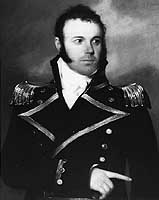Daniel Todd Patterson’s Secret Visits to Dauphin Island in 1814
November 24, 2013 in American History, general history, History, Louisiana History
Daniel Todd Patterson, commander of the New Orleans Station, made a curious visit to New Orleans notary John Lynd in late summer 1814 to record a document testifying to his continued assistance with an unnamed stranded ship at Dauphin Island, not far from Mobile. He said in the document that he was assisting the ship captain (again unnamed) with offloading cargo and supplies and bringing them to New Orleans.
Found in New Orleans’ historic treasure trove of the Notarial Archives, the Patterson document is odd for a few reasons. Chief among these reasons is Dauphin Island was quite some distance on the Gulf Coast from New Orleans, and British warships such as HMS Herald had been keeping a steady blockade of all sea traffic to and from New Orleans since early 1813. Patterson’s small fleet of gunboats could not battle a British ship full of trained sailors, yet in the document he says he is taking one boat out to the stranded ship and making a series of long trips to offload the items. The second reason the US commander’s action is strange is why would he take such an interest in assisting a ship while risking losing one of his boats, plus placing himself at risk of capture from one of the British ships? The third reason the mission was odd is the most bizarre: during the late summer of 1814, the British forces were making concerted preparations for invading New Orleans, including forays among the Indian tribes along the Gulf Coast, and they had set up a temporary base camp at Dauphin Island (proof of this is the fact that in the late 20th century, treasure hunters uncovered a cache of unused British uniform buttons at Dauphin Island, supplies that were intended to be used at New Orleans by occupying forces.)
History books of the War of 1812 on the Gulf Coast do not tell the story about Patterson’s visits to Dauphin Island in late summer of 1814. What was he really doing there? The main thing we read about Patterson during that time period is his “defeat” of the Baratarians at the Laffite brother’s smuggling base of Grande Terre, a raid by all of the New Orleans naval flotilla in which not a single shot was fired at the American forces. And then, of course, Andrew Jackson arrived on the scene at New Orleans in December 1814, and Patterson provided naval support and men to help Jackson against the British, culminating in the American victory at the Battle of New Orleans on Jan. 8, 1815. Historian Robert Remini went so far as to call Patterson “one of the most important and valuable figures in the defense of New Orleans.”
The question remains, however: what was a US naval commander doing going back and forth to Dauphin Island at a time when British forces were present there? If he was spying on them, reports of such endeavors do not appear in any official US records. Since he was able to go back and forth to New Orleans without interference from the blockaders, it looks more likely that he was spying *for* the British forces, acting as a double agent.
And then there’s the weird coincidence of the British attack on Fort Bowyer near Mobile and Dauphin Island which occurred at almost the same time in mid September 1814 as the Patterson-Ross raid on Grande Terre. The British ships failed in their mission to take Fort Bowyer even though the US Naval forces were all busy way off to the west approaching Grande Terre to arrest Baratarians and seize goods and ships. One of the British ships at Fort Bowyer was the HMS Sophie. Capt. Nicholas Lockyer of the Sophie had less than two weeks previous tried to bribe Jean Laffite at Grande Terre to join the British forces. The Sophie was supposed to return to Grande Terre within a fortnight to get Laffite’s reply, but the ship and crew never did. The timing coincidence is mysterious. The truth of what really happened behind the scenes will probably never be known.
A check of New York native Daniel Todd Patterson’s genealogy is interesting: his father came to the US in 1750 from Ireland, and was a British soldier in the US during the French and Indian War. His paternal uncle was the first Royal Governor of Prince Edward Island. Patterson’s mother was from the socially prominent and wealthy Livingston family of New York, so he was a kinsman of New Orleans attorney Edward Livingston, who just happened to represent privateers Jean and Pierre Laffite in legal matters. Livingston’s familial connections to Patterson were not known by their New Orleans contemporaries.

Recent Comments